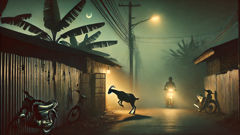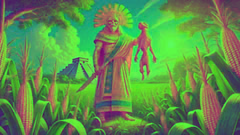Introduction
On nights when the moon hangs like a pale coin above swaying nipa roofs and the humid breath of the sea rolls inland, elders in small Visayan villages speak in lower voices about a thing that moves between shadows. They call it the Sigbin: a creature of bone and rumor, often described as goat-like, with long hind legs and a strange gait that keeps its head lowered, held between its hind legs as if in perpetual humility or concealment. The most unsettling claim is not its posture but its appetite — not for flesh caught in the open, but for the darker twin of every person: the shadow. Villagers say the Sigbin slips close to a sleeping home's doorway, waits until a household's silhouette lengthens under lamplight or moonlight, and then leans down to draw warmth and blood from that shadow without ever crossing the threshold. Mothers hush children by pointing at a smear of night-dark in the corner and warning that the Sigbin might visit in its hunger. Yet the story is more than a scare tactic; it is a map of fear and a ledger of caution. The legend marks boundaries — of place, of respect for the night, of behaviors that keep families safe — and codifies them into tales told beside rice husks and firelight. This retelling gathers those voices and recordings, the oral fragments and the careful recollections of those who still tend the fields at dusk, to weave a portrait of the Sigbin that is cultural, atmospheric, and hauntingly plausible. Here the creature is as much a mirror for human anxieties about vulnerability and secrecy as it is a supernatural predator, an emblem of how communities survive by naming the unknown and by inventing rites to keep it at bay.
Origins and Oral Histories
The tale of the Sigbin resists tidy origin stories. It moves through archipelago memory like a seasonal wind, changing its shape according to the mouths that tell it. In Visayan islands the creature is sometimes called a pet of witches, an invisible servant summoned at night to fetch things that cannot be bought. Elsewhere it is a free-roaming animal that inhabits abandoned sugarcane fields and the shadowed undersides of banana leaves. Across versions there are persistent motifs: the goat-like body, a smell that precedes it — described as a copper tang or the acid bite of rotting fruit — and the peculiar posture that lends the Sigbin both its distinctiveness and its dread. Folklorists who have catalogued Philippine myths note that this posture, walking with the head lowered between the hind legs, not only marks the creature as odd but also makes its approach uncanny in the low light of night. The silhouette reads wrong to human perception, and so it unsettles the mind as much as it threatens the body.

Stories passed down by grandmothers in coastal barangays give the Sigbin a social role. It functions as a cautionary tale about the darkness and the dangers of transgression. Young men who sneak out to meet forbidden lovers are warned that the Sigbin prefers those who cross thresholds at odd hours; those who take more than their share of a neighbor's harvest might find their home visited; and the infirm, who sleep near open windows for breath, are told to draw curtains and tie protective knots because the Sigbin is thought to prefer vulnerable shadows. These lessons are practical in a pre-electric world — keep children inside when the night calls, secure your animals, and maintain the social bonds that make a community watchful — but embedded within them is a metaphysical explanation for misfortune. When an infant becomes weak without visible cause, when a family's water buffalo pines away despite feeding, people sometimes attribute it to the Sigbin's theft. The myth personifies the invisible losses of rural life: disease, depletion, and the unpredictable whims of weather and hunger.
Etymology and inter-island comparisons complicate the picture. The word 'sigbin' itself may be a regional rendering with kin in other Austronesian terms for spirit-beasts or night monsters. Scholars have linked the Sigbin to Southeast Asian shadow beast archetypes: creatures that feed on essence rather than flesh, that slip at the margins between domestic life and the encroaching wild. The shadow theme ties the Sigbin to older cosmologies about the double. In many cultures the 'shadow' is a repository of personal vitality or a portable soul, a concept that resonates in Southeast Asia where the line between life and its luminous double is especially narrow. This is why the Sigbin's method — taking from the shadow — carves a special place for it in ritual. It is not merely an animal but a being that traffics in the intangible parts of human life.
Ritual measures reflect the myth's adaptability. In some villages, families hang a sprig of calamansi or coil a woven charm of buri palm above the door; in others, a midwife or elder will recite prayers and blow holy water at dusk. These acts are a mixture of pre-colonial practice and syncretic religion, laced with Catholic invocations, animist gestures, and pragmatic safeguards. They work as social technology: when a family performs them publicly, neighbors see the effort and are reminded to take care of their own thresholds and infirm. The Sigbin legend thus sustains not only a supernatural account of loss but also a repertoire of communal behaviors.
A closer look at narrative detail reveals how personality and motive are assigned to the Sigbin in different tellings. Some accounts paint it as mischievous rather than malevolent, stealing a child's shadow only to return it at daybreak, causing a lingering weakness but not death. Other narratives insist on its cruelty: a shadow drained completely, leaving behind a husk whose eyes glass over and whose name is spoken only in past tense. These divergent endings reflect how communities grapple with tragedy. Where death is an accepted part of the night, villagers temper the story with explanations that allow for resilience. Where loss feels senseless, the Sigbin becomes a villain against which to marshal rituals and social solidarity.
The figure of the Sigbin also intersects with witchcraft lore in compelling ways. In many stories, witches or encantadores keep a Sigbin as a companion or servant. They feed it offerings, shield it from daytime heat by burying talismans, and sometimes lose control of it when angered. The Sigbin's relationship to witchcraft is morally ambivalent; it can be weaponized against enemies or used for protection, depending on the cunning of the witch and the ethics of the tale. Thus the Sigbin functions as a liminal instrument, revealing that folklore does not simply categorize beings into good and evil but instead embeds them within networks of intent and consequence.
Comparative myth draws lines between the Sigbin and other 'vampiric' creatures across cultures, but the differences are instructive. Unlike the European vampire, which is intimate and invasive and often targets the living's blood directly, the Sigbin's theft through shadow keeps a buffer between predator and prey. This spatial metaphor — of the shadow as an extension of the self that can be trespassed without breaking the home's threshold — clarifies how communities process vulnerability. It is not only an account of predation but a commentary on what is considered private and what spills into public danger. The Sigbin reminds people that a part of you goes walking when you sleep and that part can be taken if not guarded by ceremony and neighborly vigilance.
Finally, the myth persists because it answers a need for agency in a world of caprice. When rice fails, when epidemics run through pig pens, when children become pale and listless, it is powerful to have a story that names the agent. The Sigbin may be intangible, but it gives shape to misfortune and allows the community to respond with rites, shared watchfulness, and remediating claims. To listen to these oral histories now, to trace their variations, is to hold a living map of a people's encounter with uncertainty and with the night that encroaches upon their quiet lives.
Encounters and Echoes in Modern Times
As the Philippine archipelago changed — electrification reaching some barangays, highways cutting across formerly isolated valleys, and migration scattering families to cities and abroad — the Sigbin did not vanish; it migrated into new forms. In towns that now have streetlights and motorbikes, the story has adapted. The Sigbin becomes a warning against late-night recklessness on new roads, a superstition that mutates into safety advice: do not walk alone between midnight and dawn, keep your children close, and maintain respectful distance from unfamiliar cadres of people who gather under false pretense. Urban legends recast the Sigbin in alleyways and parking lots, sometimes blending with global meme-culture descriptions of shadowy stalkers, but in rural hearts the original shape lingers, stubborn and precise.

Fieldwork with contemporary storytellers yields accounts that are simultaneously skeptical and reverent. A barangay captain, in his sixties, will laugh at younger people's fixation with cameras catching ghosts and then recount the time his grandmother blamed a string of weak calves on the Sigbin's passing. A nurse who moved to the city still keeps a small talisman on her hospital keyring because she remembers the ritual that saved her cousin during a fever. These acts are not evidence of literal belief so much as cultural memory acting as insurance against helplessness. The ritual is a mnemonic device, a talisman for the mind when it is easy to feel cut off from the old protections.
Then there are the testimony-like encounters that resist easy classification. One village remembers a series of nights after a typhoon when people in a particular lane woke weak and dizzy. No infection could be found; cattle stood unmotivated and skinny. An old woman, who had never left the island, declared that a Sigbin had been seen near the riverbank and that the village should perform a cleansing. They did so: they burned coconut shells, sang a lullaby that doubled as a charm, and placed salted fish on doorsteps as offerings. Within days the malaise eased. A researcher might interpret this as natural recovery or placebo effect, but within the community the ritual had reinforced social cohesion and focused attention on nursing the weak. The Sigbin story thus operates on two planes at once — as a cosmology for misfortune and as a practical social tool that galvanizes collective care.
Modern technology complicates folklore but also preserves it. Recordings of elder storytellers, uploaded to community pages and shared across messaging apps, immortalize versions that might have faded. A digital archive of Visayan myths can hold dozens of unique Sigbin variants, annotated with location, transcriber comments, and ecological notes. The creature becomes, in a sense, curated. Younger narrators sometimes adapt the legend further, adding ecological anxiety: the Sigbin now prowls where forests are thin and water is scarce, an omen linked to environmental degradation. That interpretation transforms the Sigbin from nocturnal thief to signpost of human-caused imbalance. When plantations clear the undergrowth where the Sigbin once lurked, when pesticides thin the populations of small animals, the Sigbin's hunger becomes a metaphor for a landscape out of balance.
At the same time, pop culture has borrowed and reshaped the Sigbin. Independent filmmakers and graphic novelists take the creature and place it in new narratives: a Sigbin turned to a companion of the lonely city-dweller, a misunderstood being seeking restoration; or a horror antagonist in a streaming short that emphasises its silhouetted gait and shadow-siphoning ways. These modern retellings are not betrayals but continuations, cultural experiments that test how the myth performs in new media. They can revive interest in older practices, inspiring urban people to travel back to ancestral towns to hear the original tales, thereby reinforcing a cycle of transmission.
Legal and scientific practitioners also interact with folk belief in complicated ways. Public health workers, when faced with communities that trace mysterious illnesses to supernatural causes, must negotiate belief with explanation. The Sigbin story has sometimes opened a door: by acknowledging fears and participating in a ritual, a health worker can build trust and then introduce biomedical measures that address the underlying causes. Conversely, where authorities dismiss folklore outright, communities can react with suspicion, making cooperation difficult. Understanding the Sigbin, therefore, becomes part of culturally competent care. It is about listening to a narrative and seeing what practical needs it encodes: food security, veterinary care, clean water, childhood nutrition.
Finally, the Sigbin endures because it frames human questions that never cease to be urgent: What parts of ourselves are most vulnerable when darkness falls? How do communities protect the frail and the young? How does a people name and respond to loss? In contemporary retellings the Sigbin's shadow-feeding can be read also as a poetic way to speak about emotional depletion — an invisible thing that drains the color from a life when loneliness, grief, or exploitation go unchecked. The myth thus expands to contain ecological, social, and psychological layers. Where once the elder's warning intended to keep a child indoors, now a generation reads the Sigbin as a lesson about guarding the self against slow, unseen harms.
Encounters that could be catalogued as folklore studies are also living stories of agency. Young conservationists use Sigbin sites as entry points for community-based forest protection. Artists stage performances that dramatize shadow and light, using the Sigbin to explore the island's colonial and postcolonial histories. Teachers incorporate local lore into school curricula to anchor ecological lessons in culturally resonant terms. Across these practices the myth is not a relic but a tool, a symbol that can be sharpened to protect, to teach, and to mourn. Listening to every version — the frightened whisper, the laughing retelling, the academic footnote, the filmed adaptation — is to understand that the Sigbin remains a part of the archipelago's imaginative ecology, a dark shape at the threshold that asks us to look more carefully at what we call loss and how we respond to it.
Conclusion
The Sigbin endures because it answers ancient human needs in changing forms. It is a creature that walks with its head tucked between its hind legs and drinks from shadows, but it is also a mirror for communal anxieties, rituals of protection, and adaptations to modern life. Whether invoked to explain a sudden household sickness, to prompt neighbors into collective care, or to teach a child caution, the Sigbin is a device by which a people name the night and negotiate survival. In contemporary times the myth has been repurposed in stories that range from environmental parables to cinematic allegories, and it has helped bridge traditional knowledge with modern concerns. If there is any moral implicit in these many tellings, it is a simple one: by giving shape to urgency and by performing rites of attention, communities make the unknown manageable. The Sigbin warns us to tend the fragile parts of life that we often ignore: our shadows, our neighbors, and our landscapes. If you walk through a Visayan lane at dusk and sense a wrong angle in the dark, it may be only a trick of light. Or it may be an old story still at work, reminding us to close shutters, to sing a lullaby, and to care for one another through the night.


















